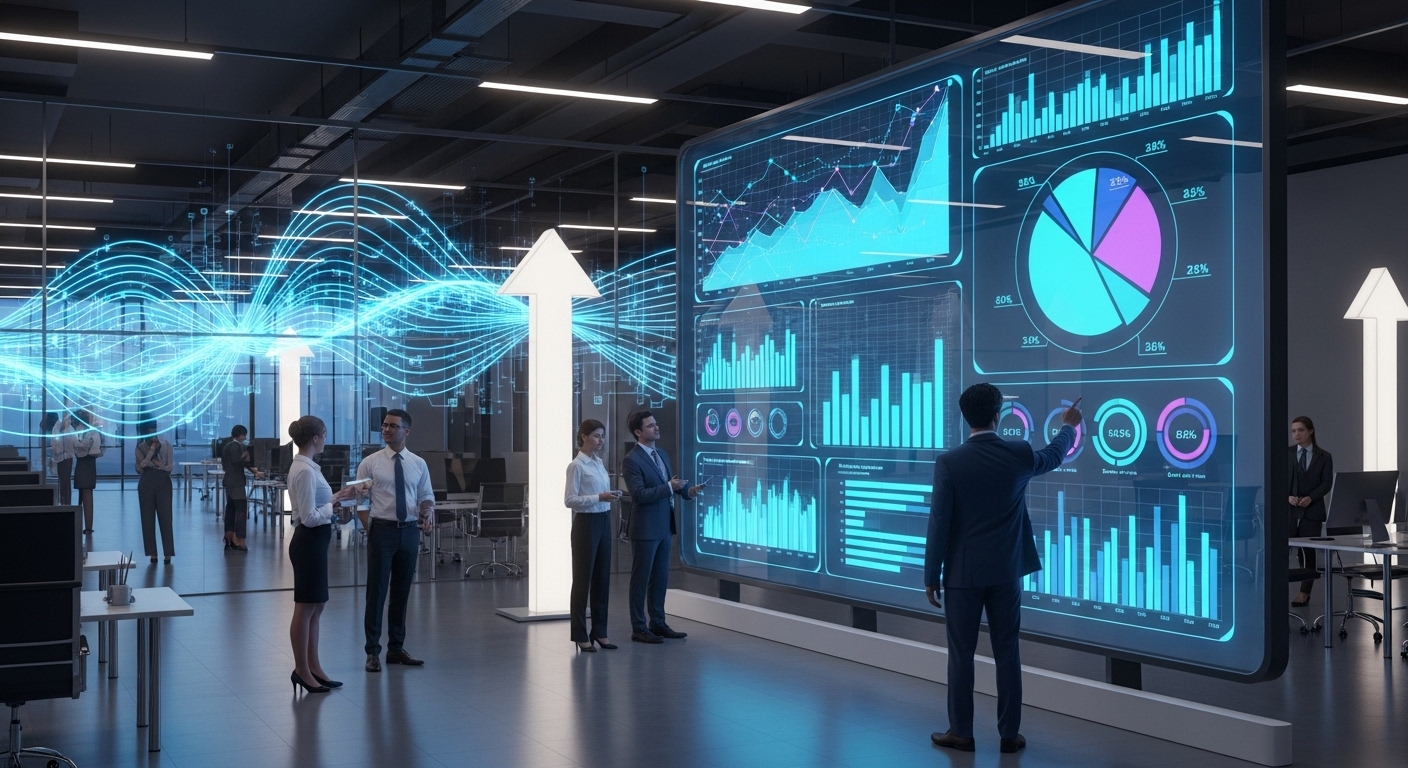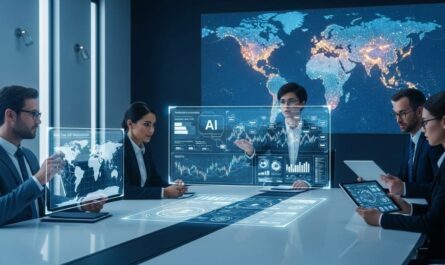Artificial Intelligence (AI), a technology designed to mimic human intelligence, is having a major impact on the business world.
AI is now ubiquitous in many types of software and applications.
AI is changing the way we work, access and analyze data, revolutionizing processes, business practices and entire industries.
1. Benefits of Using AI in Business
Artificial intelligence (AI) can bring many benefits to different departments and businesses. Noémie Ellezam, chief digital officer at Société Générale, Europe’s sixth-largest bank, described AI as an “accelerator” for their digital strategy.
According to a report by the Massachusetts Institute of Technology, AI is impacting businesses and all sectors of industry.
Here are some of the benefits that AI can bring to businesses.
Better Customer Relationships and Experience
Chatbots, callbots, and AI-powered assistants are transforming customer service. These tools are providing new and easier ways for businesses to interact with customers.
Data analytics and insights
AI can quickly process large amounts of current and historical data. This ability allows AI to draw conclusions, gain insights, and predict future trends.
These things help businesses make better decisions about customers, products, and future business growth paths.
Process automation and efficiency
AI technologies improve the process and efficiency of existing software tools. They can also automate repetitive tasks such as data entry, taking meeting notes, and creating regular content.
Personalized recommendations and targeting
AI can analyze data collected through customer preferences and purchasing behavior. This allows businesses to send personalized recommendations and targeted messages to customers.
2. Applications Of AI in Business
Artificial intelligence (AI) can be used in many business sectors. It can improve productivity and business efficiency, and promises insights, scalability, and improvements.
Below are some of the industries and applications where AI is having a major impact.
Accounting
Many accounting software currently uses AI to predict cash flow and categorize transactions. It can also be used for tax preparation, payroll, and financial forecasting.
AI can reduce data entry errors, detect duplicate or suspicious transactions, and identify cost-saving opportunities.
Content Generation
Generative AI can help with writing, researching, and editing, as well as creating images, videos, and other media. It can be used for everything from marketing campaigns to business documents like proposals and presentations.
AI can also translate languages, translate, and generate code, making it faster, easier, and cheaper for businesses to acquire these skills.
Customer Service and Support
Chatbots and callbots can expand existing customer service capabilities for businesses. They can answer a higher volume of customer inquiries, freeing up staff time to focus on more complex situations.
Additionally, AI-powered customer service centers and voice applications can summarize phone and video calls and analyze the mood of callers.
Cybersecurity
AI-powered cybersecurity tools can monitor systems activity and protect against cyberattacks. They can identify risks and vulnerabilities. AI also helps security teams analyze risks and respond more quickly to threats.
Information Technology Operations
The use of AI in information technology (IT) operations has become so widespread that a new term, AIOps, has even been coined.
AI can be used to maintain IT infrastructure and organize data. It can also automate tasks like performance monitoring, workload scheduling, and data backups.
AI can help IT professionals better understand the source of problems, resolve system issues more quickly, and predict future problems.
Financial Analytics, Trading, and Fraud Detection
Finance departments and businesses can benefit from AI-powered data analytics, model building, fraud detection, and automated compliance logging and auditing.
AI’s ability to analyze complex and large amounts of data has led investors to use AI tools to manage their investments. AI can also identify unusual patterns and behaviors in payment data and detect fraud.
Human Resources
AI can help human resources departments by automating and speeding up data collection, analysis, and processing. This system can also help with tasks such as employee record management, payroll, hiring, employee benefits management, and employee onboarding.
Legal
Lawyers and law firms can benefit from machine learning AI tools because they work with large amounts of data. These tools can analyze data, recognize patterns, and learn from it.
AI can be used in legal settings to analyze, review, research, proofread, and find errors in documents, as well as for risk assessment.
Sales and Marketing
Sales and marketing departments can use AI in many areas. AI can be incorporated into CRM, email marketing, social media, and advertising software.
Generative AI can create a variety of creative and useful content, such as scripts, social media posts, blog articles, design assets, and more.
Supply Chain and Logistics
AI can have a huge impact on the supply chain and logistics industry. AI can be used to automate tasks such as forecasting, inventory management, or picking and sorting in warehouses.
AI can also be used to allocate goods or people, schedule processes, and anticipate and plan for operational disruptions.
3. Challenges and Ethical Considerations of Using AI in Business
In October 2023, former US President Joe Biden issued an “Executive Order on the Safe and Trustworthy Development and Use of Artificial Intelligence” outlining the “potential benefits and risks” of artificial intelligence (AI).
The order stated that the responsible use of AI could solve grand challenges and improve prosperity, productivity, and innovation. However, it also warned of potential downsides, such as social and societal impacts such as discrimination, misinformation, and worker displacement.
Here, let’s take a closer look at some of the important ethical and other considerations surrounding the use of AI in business.
Ethical and Privacy Concerns
As AI is used in business applications, ethical, privacy, and security concerns about the technology have arisen. Governance for AI technology will need to consider how it will expand upon privacy and data protection laws.
AI can reproduce current and past patterns of bias and discrimination, so humans need to review the results of AI.
For example, researchers at Carnegie Mellon University found that Google’s online advertising system reinforces gender bias in the workplace. The system shows men more often than women in higher-paying positions.
However, employees seem to trust their employers when it comes to using AI. A McKinsey & Company report in 2025 found that nearly three-quarters (71%) of employees surveyed believed their employers would use AI responsibly.
Skills Gaps and Workforce Transformation
AI can provide employees with skills like coding, translation, and writing, but it also creates new skills gaps. Because AI is a rapidly evolving technology, training and continuous learning about AI tools is a challenge for employees and businesses.
A 2023 Microsoft Small Business Survey found that only 10 percent of businesses with up to 24 employees “know how to use AI in their work.” 67 percent said they “know little or nothing about AI.”
In Microsoft’s 2024 Work Trend Index Annual Report, 60 percent of small and medium-sized business leaders said they “would not hire someone who doesn’t have AI skills.” But nearly 61 percent said their company “has no goals or plans to use AI.”
Concerns about worker displacement
There are growing concerns about the potential for worker displacement due to the use of artificial intelligence (AI).
But they believe it remains to be seen how AI relates to inequality. They say the impact of AI will depend on how it is created and used. In particular, whether AI is seen as a complement to humans or as a replacement.
For example, AI can be used as a personal assistant or a personalized tutor in the workplace, improving people’s skills and productivity. AI can also help people get hired by helping them write and edit resumes.
MIT professor John J. Horton suggests that business leaders consider the following factors before deciding to replace humans with AI:
- How long will the job take
- How much will the employee be paid
- Can the AI do the job correctly
- How easy is it for a human to verify that the AI’s results are correct
According to a study by the International Monetary Fund (IMF), by 2024, nearly 40 percent of jobs worldwide could be affected by AI. This includes high-skilled jobs.
The study found that 60 percent of jobs in developed economies could be affected by AI. Half of these could benefit from increased productivity, while the other half could be affected by lower wages due to reduced labor demand. The worst-case scenario is job losses and reduced hiring.
So, the impact of AI is much smaller in developing markets (40 percent) and in low-income countries (26 percent). This suggests that as AI becomes more widely used, inequality could worsen over time.
Integration and Compatibility Issues
Businesses that are successfully using AI technology see AI as part of their digital strategy. They understand where and how to use it.
To understand this, you need to consider how it will integrate into your current software and processes. This includes how you will capture, process, analyze, and store data.
Another important factor is the technology architecture of an organization. AI must be able to seamlessly integrate with existing and future systems to capture data from across the organization.
4. AI’s Future Path and Business Opportunities
As AI becomes more embedded in consumer technology, the focus may shift from AI-powered apps to AI assistants built into websites, software, and hardware. For example, Samsung’s Galaxy S24 Ultra features a text-transcribing assistant, “circle to search,” and real-time translation capabilities.
“As technology continues to dominate, collaboration between governments, businesses, and individuals is more important than ever,” says Adriana Hoyos, an economics professor at IE University. “Collaborations can be the foundation for innovation,” she says.
Microsoft’s partnership with OpenAI is one example of how everyone is committed to using AI responsibly. However, Hoyos notes that governments “have a responsibility to adjust laws to keep pace with technological advances.” She predicts that areas such as big data analytics, climate change technology, encryption, and cybersecurity will drive future job growth.
Most successful companies are approaching AI to enhance existing processes and operations, rather than aiming to replace people with AI. This future is evident in AI-assisted software development, and AI researcher David De Cremer and chess grandmaster Garry Kasparov have called the future of humans and AI working together a “new multi-faceted partnership.” This is the way humans and AI work together. To do this, we need leaders who can create inclusive teams and bring together diverse organizations.
5. Can you use AI to start a business?
AI can be used to generate business ideas, write business plans, and even guide you through the steps needed to start a business.
AI can streamline time-consuming tasks like designing websites, writing emails, and scheduling meetings, helping entrepreneurs save time and focus on what matters most.
6. Will AI replace humans in the future?
Estimates of the impact of AI on the workforce in the future vary.
An IMF study in 2024 found that nearly 40 percent of global jobs could be affected by AI. But whether AI will replace existing jobs or have a negative impact depends on the experience of employees, their current income, and the country’s economic situation.
7. Will AI replace humans in the future?
Estimates of the impact of AI on the workforce in the future vary.
An IMF study in 2024 found that nearly 40 percent of global jobs could be affected by AI. But whether AI will replace existing jobs or have a negative impact depends on the experience of employees, their current income, and the country’s economic situation.
8. How is AI used in business analytics?
Artificial intelligence (AI) and analytics tools can help business analysts and decision makers gain insights from large, complex datasets.
They can also automate repetitive tasks, such as formatting data or generating reports. Predictive analytics can also identify future trends and patterns from current and past data.
9. How is AI being used in healthcare?
There are many applications for AI in healthcare.
AI can analyze vast amounts of health data, such as patient records, clinical studies, and genetic information.
AI chatbots can help answer patients’ questions, and generative AI can be used to create and test new pharmaceuticals. AI-powered robots can even be used to perform surgeries with less impact.
10. What is the impact of AI on businesses?
AI is having a huge impact on businesses, improving efficiency and productivity for employees and businesses alike. But whether it will replace human jobs remains to be seen.
One trend for 2025 is the increased use of agentic AI, or AI agents. These digital assistants can automate complex tasks, streamline processes, and collaborate with humans to improve decision-making and productivity.
Also Read: Google AI Mode Explained: How It Impacts Your Website Traffic
The Bottom Line
It is a useful way to think of the future of AI for businesses as capabilities rather than technologies.
AI can help businesses in three key areas.
- Automate processes.
- Analyze data to gain insights.
- Improve customer and employee engagement.
Companies that strategically use AI in these ways can reap significant benefits in terms of productivity, efficiency, potential cost savings, and growth.
However, AI also brings challenges with its opportunities. These include data privacy, security, ethical considerations, growing inequality, and the potential for job displacement.
According to researchers and analysts, collaborative approaches between businesses, governments, and other stakeholders are key to responsible use of AI and innovation.




